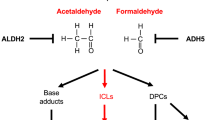Abstract
EXPOSURE to chromosome-damaging chemicals during prenatal development is particularly hazardous, since stem-cells needed to support tissue maintenance throughout life may then be at risk. Lesions in fetal cells lead to cancer in early life, and in germ-cell lineages, contribute to increased inherited abnormalities. Chemicals can be screened for chromosome-breaking potential in vivo by the micronucleus test1 which measures frequencies of acentric chromosome fragments2. Micronuclei are usually scored in polychromatic erythrocytes from adult rodent bone-marrow. This short-term test is claimed to be as reliable as the more laborious analysis of metaphase chromosomes for chemically-induced visible aberrations3,4. The reactive forms of chromosome-damaging chemicals are often metabolites formed within tissues of exposed individuals. Short-term methods to determine genome-damaging potential must incorporate realistic activating systems if derived risk-estimates are to be meaningful. Although fetal organs contain enzymes which activate mutagenic/carcinogenic chemicals5, the micronucleus test has not previously been applied to transplacental exposure. Adult bone marrow has limited activation capacity and short lived mutagens/carcinogens formed in other tissues may not survive in the circulation, so false-negative results can be obtained. Late in gestation, blood cells develop in the fetal liver, alongside hepatocytes which metabolise premutagens/carcinogens to active forms. We show here that transplacental exposure to chemicals which require metabolic activation can cause chromosome breakage, indicated by micronucleus formation, in mouse fetal tissue. The dose dependence of this intrauterine genetic damage can be measured, thus providing a method for quantitative assessment of risks inherent in prenatal exposure to certain classes of carcinogenic and mutagenic chemicals.
Similar content being viewed by others
References
Schmid, W. Mutat. Res. 31, 9–15 (1975).
Heddle, J. A. & Carrano, A. V. Mutat. Res. 44, 63–69 (1977).
Wild, D. Mutat. Res. 56, 319–327 (1978).
Frank, D. W., Trzos, R. J. & Good, P. I. Mutat. Res. 56, 311–317 (1978).
Sehgal, C. B. & Hutton, J. J. Mutat. Res. 46, 325–344 (1977).
Tarbutt, R. G. & Blackett, N. M. Cell Tissue Kinetics 1, 65–80 (1968).
Paul, J., Conkie, D. & Freshney, R. I. Cell Tissue Kinetics 2, 283–294 (1969).
Tarbutt, R. G. & Cole, R. J. J. Embryol. exp. Morph. 24, 429–446 (1970)
Wheldon, T. E., Kirk, J., Orr, J. S., Paul, J. & Conkie, D. Cell Tissue Kinetics 7, 181–188 (1974).
De Serres, F. J. Mutat. Res. 41, 43–50 (1976).
McCann, J., Choi, E., Yomasaki, E. & Ames, B. Proc. Natn. Acad. Sci. U.S.A. 72, 5135–39 (1975).
McCann, J. & Ames, B. Proc. natn. Acad. Sci. U.S.A. 73, 950–954 (1976).
Author information
Authors and Affiliations
Rights and permissions
About this article
Cite this article
COLE, R., TAYLOR, N., COLE, J. et al. Transplacental effects of chemical mutagens detected by the micronucleus test. Nature 277, 317–318 (1979). https://doi.org/10.1038/277317a0
Received:
Accepted:
Issue Date:
DOI: https://doi.org/10.1038/277317a0
- Springer Nature Limited
This article is cited by
-
The micronucleus test—most widely used in vivo genotoxicity test—
Genes and Environment (2016)





